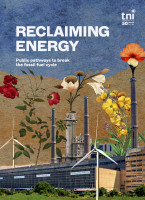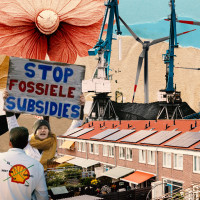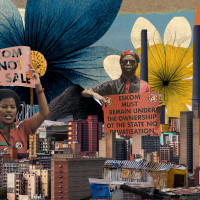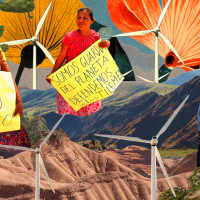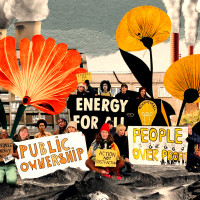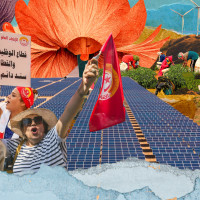Public energy and the popular struggle for democracy in Costa Rica Energy transition country struggle
Regions
From the end of the 1940s until the 1970s, Costa Rica built a successful publicly governed electricity system, featuring a unique combination of a state-owned utility, a regional enterprise, two municipal enterprises and four rural electricity cooperatives. Since the 1990s, this model has been under severe strain, for two very different reasons. On one hand, it has been increasingly threatened by the ongoing onslaught of privatisation. On the other hand, some energy projects are facing legitimate resistance from social and environmental movements. These movements have been foundational in Costa Rica's current energy model, pushing the government to instil meaningful citizen consultation processes and diversify the country’s energy sources.
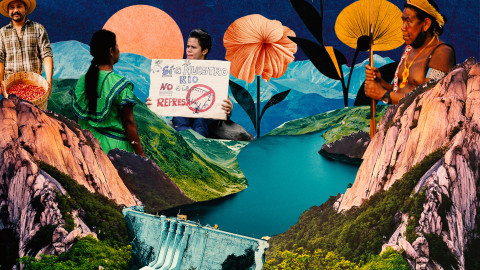
Illustration by Fourate Chahal El Rekaby
This country case was updated and republished as part of the report Reclaiming Energy: Public pathways to break the fossil fuel cycle and is an adapted version of the article that was published on 12 October 2023.
Source: ourworldindata.org2
The Costa Rican Electricity Institute (ICE) has played a key role in these achievements. ICE is a state-owned and vertically integrated enterprise, responsible for providing energy and telecommunications services. It was set up as part of a set of social reforms following the end of the civil war in 1948. ICE played a fundamental role in these reforms by providing the energy required to implement the state-backed development and industrialisation plans. It also enabled the expansion of welfare policies by facilitating households’ access to electricity.
The electricity system that took shape consists of: i) ICE and its subsidiary, the National Power and Light Company, which supplies the centre of the country and the metropolitan area; ii) municipal companies which supply electricity and provide backup generation; iii) four energy cooperatives, which focus mainly on rural electrification. ICE generates about 75 per cent of the electricity in Costa Rica, while just over 3 per cent is produced by CNFL, about 6 per cent by cooperatives and municipal enterprises, and 16 per cent by private power generation companies. The latter are the result of a process of opening up the electricity system to private capital, which began in 1990.
The state-municipal-cooperative governance model
At an early stage, ICE absorbed a company set up in 1941, the National Power and Light Company (CNFL), which was itself the result of the merger of three private companies. ICE and CNFL together comprise what is now known as the ICE Group.
In the mid-1960s, the Cartago Municipal Electricity Service (JASEC) was given partial authorisation for power generation, distribution and supply, and in the mid-1970s the Heredia Public Services Company (ESPH) was created. The latter is a municipal company that distributes electricity, provides street lighting, drinking water and sanitation services, and has also become involved in electricity generation. These two municipal enterprises have relatively small amounts of installed capacity and the power they generate operates mainly as a backup supply. In their role as distribution companies, they do not compete with the ICE Group, but have assigned territories that they serve exclusively. Despite occasional disputes, coordination, cooperation and complementarity prevail.
Rural electrification cooperatives have also existed since the 1960s. The cooperatives operating today are COOPESANTOS, COOPELESCA, COOPEALFARORUIZ and COOPEGUANACASTE. Together, they cover about 400,000 users and 20 per cent of Costa Rica’s territory. They are not-for-profit entities and reinvest their earnings in improving and expanding operations. Some have expanded their business activities to other sectors such as telecommunications and drinking water. In 1989, they set up a consortium called CONELECTRICAS R.L. for the purpose of defending the interests of the cooperative sector and strengthening their operations. In 2013, COOPELESCA was the first energy company in Latin America to obtain carbon neutral certification and, since 2015, it has been implementing a strong policy to mitigate the negative impacts of electricity generation, as well as supporting community initiatives.3
In contrast to some experiences elsewhere, the cooperatives in Costa Rica have a strong public service vocation. A clear example of this was seen during the ‘ICE Combo’ privatisation attempts in the 2000s, when the electricity cooperatives were among the defenders of ICE as a state-owned enterprise. 4
Costa Rica’s public power model has shaped the success story of the country’s electricity system. Beyond the amount of power production, in the last few years the municipal enterprises and the rural cooperatives have together accounted for about 20 per cent of electricity sales, with relatively similar market shares. This illustrates their importance within the sector. For those who see energy democracy as synonymous with decentralisation and small-scale operations, the presence of ICE as a vertically integrated state-owned enterprise that governs most of the electricity system is uncomfortable. Meanwhile those who associate energy democracy with large-scale, publicly-owned and vertically integrated monopolies may see the existence of the back-up municipal enterprises and rural electricity cooperatives as a deviation from the model. However, the Costa Rican experience demonstrates the potential for linking these two models of energy democracy in a coordinated way, with demonstrable success.
The system’s main weakness is limited popular participation in decision-making. There has been some progress around popular dialogue in recent years, in response to significant social protests against hydropower projects. The credit for this is due to the protests organised at the local level rather than to ICE itself. There have also been attempts to make ICE’s management more responsive to the needs of local communities, for example in how it manages the greenhouse gas-emitting biomass from dams and reservoirs.
Privatisation push
The drive to increase energy democracy is counterposed by a strong push to privatise. Since 1990, changes have been made to ICE’s governance arrangements. For example, Law 7200 introduced competition in electricity generation, although it kept ICE as the only buyer. Thus, there is still an ethos of public service in which the state maintains ownership and decides whether to allow private entities to provide the service under contract and, if so, on what terms.5
The new framework that began to be introduced in the 1990s changed the face of the Costa Rican electricity system. In particular, it involved bringing in about 30 private generation companies, which focused on generating wind and geothermal power.6 Law 7200 authorised each company to have a maximum installed capacity of 20,000 KW and a maximum total market share of 15 per cent. In 1995, these limits were increased to 30 per cent and 50,000 KW respectively . Since then, the involvement of private power generation companies has been increasing, rising from 11 per cent at the end of the 1990s to over 25 per cent now, placing them near the limit of their permitted share.
Against this background, the Public Services Regulatory Authority (ARESEP) was set up in 1996. Its duties include rate setting and it is mandated by law to determine rates based on operating costs and investment needs in the sector. This approach contrasts to that of the typical neoliberal regulator, whose main objective is to promote competition and set rates based on marginal costs instead of system costs, favouring private power producers. ARESEP’s priorities include defending the public service, regardless of whether competition from the private sector is allowed.
During the presidency of Miguel Ángel Rodríguez, from 1998 to 2002, a strongly neoliberal agenda was pursued, which included taking certain assets out of state ownership. A political pact between different groups in parliament led to the drafting and partial approval of three proposed laws: the ICE Transformation Act, the General Electricity Law and the General Telecommunications Law. These three bills were combined into one and popular ingenuity rapidly baptised them the ‘ICE Combo’.
The ‘Combo’ proposed to liberalise the electricity and telecommunications sectors – the two areas in which ICE operates – and open them up to competition. It was approved by the majority of members of parliament (47 out of 57). However, this privatisation attempt was met with popular protests unprecedented in Costa Rica, to the point where parliamentary discussion came to a halt in as little as six weeks. A Constitutional Court ruling subsequently buried the bill in its original formulation for good.7
Resistance
Costa Rica has a long history of social movements, particularly community, Indigenous and environmental groups forming coalitions that not only resist, but shift policy on resource extraction and use. The anti-dam movement opposed the development of new hydroelectric dams due to their vast impacts on biodiversity and environmental degradation. These dams were infringing on Indigenous territories and harming local livelihoods. In 2001, one such coalition, also involving regional and national organisations through the Federación Ecológica Nacional (FECON), instigated a series of national forums that resulted in a proposal for a new national energy plan that centred community consultation, sustainability and new energy technologies such as more affordable wind and solar. Thirteen years later, these principles were incorporated into the Ministry of Environment and Energy’s 2015 National Energy Plan.8 This demonstrates the power and importance of sustained social struggle to achieving policy results.
The resistance to the ICE Combo was another diverse movement. Broadly speaking, it was a trade union-led protest against privatisation. The ICE unions were supported by a swathe of other unions and the student movement. These organisations were backed in important protests by the farmers’ movement and by Indigenous communities with strong territorial roots, who in turn also fought to prevent the destruction of their territory by the advance of hydroelectric dams.9
The anti-dam initiatives have used legal channels, moratoriums, municipal-level plebiscites, protests and even international campaigning to stop around 35 projects. Some of these projects were in the early stages of administrative procedures and others were at a more advanced stage – in some cases, construction work such as road building and diverting watercourses had already begun.
Community resistance has been organised against both private and public sector hydropower projects and, to a lesser extent, those initiated by cooperatives and municipal enterprises.10 Take the campaign against the Diquís project. This ICE project would have been the largest hydroelectric dam in Costa Rica. Following years of protest and campaigning for alternative energy mix proposals, the project was abandoned.11 This demonstrates the importance of social movement organisations in keeping public utilities accountable.
Privatisation threat returns
As we write, the Costa Rican parliament is discussing a series of bills that would substantially change the Costa Rican electricity system. One proposed change is the modification of ICE’s role in the electricity market. This bill would deprive the utility of its power to plan and manage the sector, giving this role to private companies and the executive branch of government. These changes are pursued by the private power generation sector and would lay the institutional foundations for the creation of a commercial electricity market.
Another of the proposed changes is to remove ICE’s monopoly over buying electricity, enabling private companies to sell power freely to distributors and large consumers, as well as to the regional market. These proposed reforms threaten a new privatisation cycle that puts the utility and electricity as a public service at risk.
While the trade union movement was at the centre of the resistance in the late 1990s, today the strongest resistance appears to come from local social movements. These movements are warning of the dangers of increasing private sector involvement in power generation, arguing that this would prioritise business interests over the needs of the Costa Rican people.
The historic successes of Costa Rica’s public governance model – a model that serves as inspiration to the rest of the world – are at risk. This is why we need to build local resistance out into a global energy democracy movement – a movement in defence of the Costa Rican model and the vision of sustainability, justice and democracy it represents.
